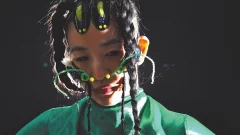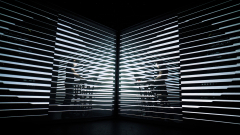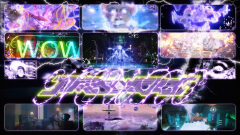Shanghai collective SVBKVLT tell the story of their groundbreaking approach to club music.
This feature was originally published in Fact’s F/W 2020 issue, which is available to buy here.
In Star Wars: Episode IV–A New Hope, there is a cantina in the spaceport city Mos Eisley that Obi-Wan Kenobi describes as a “wretched hive of scum and villainy.” Inside, quad-eyed, furry extraterrestrials gather alongside crocodilian creatures puffing on vapes as they enjoy watching a cadre of aliens playing the oboe. Chinese producer Han Han, known by his artist alias Gooooose and an affiliate of the salient Shanghai-based imprint SVBKVLT, explicitly states that he is not a huge fan of George Lucas’ epic space franchise, but “I dig some classic concepts in there,” he admits. That is to say, he can’t help but use this sordid, intergalactic tavern as an analogy for what it’s like to party at ALL club. Nevertheless, Han Han points out, “I would specifically avoid using the work ‘cyberpunk’ to describe it, because I think that’s a very obsolete and limited globalisation.”
In his few years in SVBKVLT, Han Han has seen his fair share of Western media coverage revering the city’s milieu as some kind of dystopian, sci-fi hinterland. So when he talks about the scene in Star Wars, he’s more referring to the remix of alien, robot, cyborg and human life forms from disparate planets—similar to how the international expats, Shanghainese natives and domestic Chinese transplants intermingle at ALL—rather than underscoring that his scene consists of exotic representatives from the radical future. The plurality he describes here is not exclusive to mere identity: It extends to the deliberately incongruous aesthetics, sounds, and inspirations of the clubbing counterculture.
Those paying attention in the global underground credit ALL club as the conduit for the outré Shanghainese dance music transmitting shockwaves to the rest of the world. Located in the Jing’an district, a hectic commercial area known for its international hospitality, the venue was founded in summer 2017 by Gareth (Gaz) Williams months after the closure of his former club Shelter on New Year’s Eve of 2016. Visual artist and SVBKVLT affiliate Kim Laughton designed ALL’s concrete interior. Salvaged materials from the inside of cooling towers make up the undulating wall installations, and black seats dot the bar lounge, rounding out the club’s functional, brutalist feel. Most notably, unlike Shelter, “the bathrooms don’t feel like they were designed by a teenager,” Williams told Time Out Shanghai, two weeks after the club’s opening. Though ALL’s minimal recesses are a far cry from Shelter’s moist bunker, both spaces are considered a beloved, permissive platform for the nightlife community.
The avant-experimentalism of ALL is closely associated with another one of Williams’ ventures, the label SVBKVLT. Launched in 2013, the imprint releases works by Han Han, Hyph11E, Osheyack, 33EMYBW and Yen Tech, among others, as well as showcasing visuals by artists like Laughton and Wang Jingxin.
Musically, SVBKVLT is largely unified by the kind of mutant, propulsive electronics that sound as if they are aggressively racing away from categorisation. Han Han is one such culprit of this; his sound is as peripatetic as his background. He was born in Anhui, a province known for its calligraphy culture and poetic, coniferous vistas, but his family moved several times, which is why he attests he was “never a native of any city.” Around 2007, he met Shanghai native and current SVBKVLT labelmate 33EMYBW through running his then-label Miniless Recordings, focused on shoegaze, noise, math rock, and post-rock. Two years later, he decided to move to Shanghai, partially because the two of them were “talking about playing some less boring stuff together a lot on MSN,” and partially because they knew they liked each other. That year, the pair joined with members Panda and JB to form the four-piece band Duck Fight Goose.
But in 2012, his flirtations with Shelter changed everything. “Sonically, that place is like a gooey chunk of alien mucus made of sub bass,” he describes affectionately. Before he ever met Williams, he would go there on Wednesdays alone, get drunk, and lean against one of the giant pillars to feel the bass reverberate through him. Han Han was oddly comforted by the fact that it was “dark, wet, and smelled like a second hand ashtray.” Suddenly, after these 3am nights, he remembers, “even those weirdo bands you found at Soulseek all sounded alike, especially when compared with sounds from Warp, Planet Mu, Editions Mego, Rune Grammofon, or PSF from Japan.” He grew bored with rock music again, pivoting to vigorous electronics with his solo project Gooooose.
This late August saw the release of Han Han’s collaborative JAC EP with Berlin-based Japanese producer DJ Scotch Egg, a twitching, polyrhythmic workout which he jocularly describes to me as “an old, big ass computer keyboard that fell into the dirt somewhere in Africa several years ago, but works perfectly.” Shanghai native 33EMYBW, simply known as 33 (pronounced San San) is now Han Han’s longtime partner. “It’s a blessing to live with someone that digs and hates the same music with you!” he laughs. His penchant for prevarication must have rubbed off on her because, when I ask about her sonic reference points, 33 tells me, “I never think about genres when making music, but I would like to try in the future.”
Instead, her inspiration comes from arthropods. “They are the most diverse animals on the planet,” she explains: “Each of the units in their body has a separate set of nerves, and different segments of the body has different functions. The mechanical beauty of this kind of creature is very similar to the rhythmic flow in my music.” Her love affair with the invertebrate animals is evident on her 2019 album Anthropods, with the standout track ‘Arthropods Continent’ (featuring Li Jianhong), wherein every hollow percussive rattle feels like an auditory representation of various insect movements. On its cover, 33’s head appears rendered onto a red, lacquered CGI version of a crustacean with two centipede bodies as arms, meanwhile black- and-white marbled slugs feed on her thorax. 33’s obsession extends to the way she presents herself aesthetically, too. Her beaded facial jewellery gives her the appearance of having compound eyes and her signature braids hang like two antennae drooping onto her face.
The SVBKVLT gestalt cannot be flattened into a cohesive language, and yet, against all reason, it still maintains a distinctly Shanghainese sensibility. Eli Osheyack, whose artist alias is his surname, moved from Chicago to Shanghai in 2012. He has seen the way the city has gradually embraced dance music culture since the Shelter’s halcyon days, and believes, “The sound comes from how the artists digest and reframe music to make sense in the context of the city, clubs and audience here.” He, like 33, doesn’t explicitly take influence from other forms of music, although keen listening is a key part of what he does.
Oftentimes, Osheyack tells me, he’ll write several “interlocking parts” of the songs or sound palettes he’s interested in and sutures those into a live set. “The conversation is accelerated in the club, so a lot of ideas start at ALL,” he says. The club is the crucible for his output, keeping things from becoming “too abrasive, experimental or pretentious.” Where inspiration for 33 comes from dreams, animals, or plants, Osheyack is similar to Han Han in that he looks to the intuitive elements of ambiance, architecture, and urban circumstance to modulate his work. “The music being made and the clothes people wear are a direct response to the clubgoer’s environment,” Osheyack explains. “There are a lot of Tao Bao [China’s mega eCommerce website] outfits because it’s quick, cheap, and almost anything can be manufactured. A lot of music being made is aggressive and fast because that’s what it feels like living here. Shanghai lives in the present.”
It’s likely that Shanghai’s clubland lives in the present because there are no rulebooks to consult from the past. Nocturnal culture is still a relatively new invention in China, only gaining traction in the 1990s due to efforts by the national government to aid urban regeneration and to bolster tax revenues and international tourism. Matthew M. Chew, professor of sociology at Hong Kong Baptist University, who wrote the 2009–10 paper ‘Research on Chinese Nightlife Cultures and Night-Time Economies’ notes that there was another brief period of suppression in the very early aughts, before these policies reversed. The state re-welcomed this auspicious economic force. Suddenly, hostess karaoke bars popped up in remote Sichuan mountain villages, and, around Shanghai, nightclubs became synonymous with the type of cosmopolitan, conspicuous consumption of China’s nouveau riche. Chew writes, “Whereas electronic dance music was consumed (at least in the beginning) in grass-roots, subcultural mode in the United Kingdom, it has been consumed largely as a globalised, upper-middle-class, and elite cultural genre in China and other non-Western contexts.”
At the age of 25, Williams broke this mould when he opened Shelter in 2007 and introduced Shanghai to his no-frills, Mancunian approach to clubbing. Prior to this, he had briefly visited China during his gap year to teach English in Qingdao in 2001 and studied at Shanghai University between 2005 and 2006. Growing up, he watched his father, a youth and community organiser, as well as a party promoter, put on music events and mediate cross-cultural connections between adolescent groups around Europe.
What Williams does now is not so different to what his father did before him. The agitated scribbles of Slip B, an EP by Hyph11e and Uganda’s Nyege Nyege/Hakuna Kulala affiliate Slikbak, for instance, emerged from a SVBKVLT three-week residency intended to bridge the East Asia and East Africa divide. The JAC EP came about because Williams suggested to Han Han the idea of bringing DJ Scotch Egg to Shanghai after the two met at Nyege Nyege Festival in 2019. Even the way Han Han describes the week’s studio session sounds like the itinerary of a teenage exchange programme—antics included. Every day, they would meet at 2pm, “not talk much for around five hours,” record everything, then wrap up and go to dinner together. “It was like summer vacation with high school bandmates somehow,” Han H




